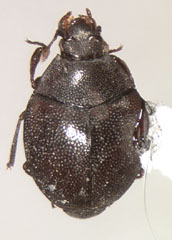Anapleini
Michael S. Caterino- Anapleus compactus
- Anapleus nakanei
- Anapleus hagai
- Anapleus marginatus
- Anapleus nomurai
- Anapleus raddai
Introduction
The Anapleini, at present containing only the genus Anapleus with 15 recognized species, is a relatively obscure group of histerids. Species are known from most of the Holarctic region, including a couple from Mexico. Its members are very rarely collected. All are smallish, from 2-3 mm, ovoid, and are probably best described as nondescript. Nothing is known of the life history of any of the species. Recently, however, the group has come to greater prominence; it is proving to be very interesting phylogenetically. Ohara (1994) and Caterino & Vogler (in press) have shown that Anapleus species exhibit plesiomorphic characters of both male and female genitalia, and the combined data analysis of the latter resolves the genus as potentially the sister group of the remaining members of the family. Hopefully their newfound prominence will lead to greater discovery of species and natural history information.
Characteristics
Anapleus has historically been placed in the Dendrophilinae, and although this subfamily has been conclusively demonstrated to be artificial (Slipinski & Mazur, 1999; Caterino & Vogler, in press), Anapleus does share several characteristics with other former members of Dendrophilinae. Most notably, the species of Anapleus have a prosternum which is prolonged anteriorly, but which does not extend laterally to conceal the antennae; that is, the lateral prosternal groove is exposed. Among taxa which share this characteristic, only Anapleus and Dendrophilus have inwardly directed, v-shaped antennal club sutures. Anapleus is generally smaller than Dendrophilus, and entirely lacking in elytral striae.
Discussion of Phylogenetic Relationships
The phylogenetic relationships among Anapleus species have not yet been investigated.
References
Caterino, M. S., and A. P. Vogler. 2002. The phylogeny of the Histeroidea. Cladistics 18(4):394-415.
Ohara, M. 1994. A revision of the superfamily Histeroidea of Japan. Insecta Mastumurana (N.S.) 51:1-283.
Slipinski, S. A., and S. Mazur. 1999. Epuraeosoma, a new genus of Histerinae and phylogeny of the family Histeridae. Annales Zoologici (Warszawa) 49:209-230.
Title Illustrations

| Scientific Name | Anapleus cyclonotus |
|---|---|
| Location | India |
| Specimen Condition | Dead Specimen |
| Image Use |
 This media file is licensed under the Creative Commons Attribution-ShareAlike License - Version 3.0. This media file is licensed under the Creative Commons Attribution-ShareAlike License - Version 3.0.
|
| Copyright |
© 2002

|
About This Page

Santa Barbara Museum of Natural History, Santa Barbara, California, USA
Page copyright © 2002
 Page: Tree of Life
Anapleini.
Authored by
Michael S. Caterino.
The TEXT of this page is licensed under the
Creative Commons Attribution License - Version 3.0. Note that images and other media
featured on this page are each governed by their own license, and they may or may not be available
for reuse. Click on an image or a media link to access the media data window, which provides the
relevant licensing information. For the general terms and conditions of ToL material reuse and
redistribution, please see the Tree of Life Copyright
Policies.
Page: Tree of Life
Anapleini.
Authored by
Michael S. Caterino.
The TEXT of this page is licensed under the
Creative Commons Attribution License - Version 3.0. Note that images and other media
featured on this page are each governed by their own license, and they may or may not be available
for reuse. Click on an image or a media link to access the media data window, which provides the
relevant licensing information. For the general terms and conditions of ToL material reuse and
redistribution, please see the Tree of Life Copyright
Policies.
- First online 07 March 2002
Citing this page:
Caterino, Michael S. 2002. Anapleini. Version 07 March 2002 (under construction). http://tolweb.org/Anapleini/9377/2002.03.07 in The Tree of Life Web Project, http://tolweb.org/








 Go to quick links
Go to quick search
Go to navigation for this section of the ToL site
Go to detailed links for the ToL site
Go to quick links
Go to quick search
Go to navigation for this section of the ToL site
Go to detailed links for the ToL site